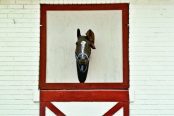As Avant-Garde as all that: Korean sonic collective Balloon and Needle distort the medium.
Cracked electronics, chin stroking and a serious aversion to anything fun, Avant-garde music can be a real rutted drag. The stakes are high and expectations huge that whatever the artist does must contain some thought of note and notes of thought. On such a stage enter Balloon and Needle.

Formerly known as RELAY (2005-2008) this tight group of Korean musical explorers have started to make a name for themselves both in their native land and also in Europe. Their particular form of sonic experimentation of ‘cracked everyday electronics’ is abrasive and yet highly entertaining, if not terribly musical per se. While billed as a collective, for their 3 day residency at Cafe OTO each performed a solo take on the basic premise of reworking generated electronic noise; playing ‘fixed’ cd players, harvested hard disks and augmented typewriters to generate random noise within artistically chosen parameters.
Sonically, there wasn’t a massive degree of variation from the some of the astructural glitch released by Mille Plateaux ten plus years ago. However, the move away from laptop sets to something electro-acoustic and performative gave the degraded machine music an organic sensibility, as though the destruction, hybridisation and recycling of these obsolete artefacts were part of natural processes. To be clear, Avant-Garde music isn't necessarily about extending conventional appreciations of tone and so we're presented here, not with the question of quantifiably how these noisy clicks are different, but why they are in light of the processes that created them.
The first standout performance came from Ryu Hankil who started by typing impassively at an old typewriter, each key producing an agitato symphony via a myriad of motors that noisily interfered with an attendant snare drum. The skin of the drum, creatively littered with various metal objects jittering out of place were manipulated by Ryu, who with a playful determination reset the skin at various intervals.
Musically, the performance wasn’t particularly interesting, however the manner in which the noises punctuated the theatre of Ryu resetting the skin or typing phrases allowed a number of propositions. The relationship between the syntax and structure of Ryu’s typing gave a direct structure to the piece, so we were in effect listening to a linguistically structured ‘poem’ distorted through an imperfect yet entropically organised organ (the drum). During the creative reverie of this organic metaphor, one wonders whether this was a remark on the distortions of human speech and the mimetics of thought or even, ahem, Chinese Whispers.

Whether we were ‘listening’ to a national anthem, love letter, lauded poem, recipe or random keypunching was irrelevant as the imperfect medium reduced any direct meaning to a crackling and distorted cacophony. That the piece concluded when Ryu had typed to the bottom of the sheet suggests some meaning in the typing, or at least a playful flourish to signify an end. As a whole we can read the performance as imparting equal volumes about messages from authority or individual communication, both reduced to a literal meaninglessness. But in the midst of what might be an essay on nihilism we had Ryu, constantly typing, considering, or resetting the skin, surely an optimistic statement on creativity.
Choi Joonyong, by comparison gave an ecstatically received performance using the reasonably simple set-up of twinned CD players and Fender amps. The CD players had had their lids removed allowing Choi to directly affect the spinning disks by attaching and reattaching pieces of tape to create staccato flicks of white noise with each rotation. The soft interlocking clicks and pleasant whirs didn’t grab the audience until the artist started moving the amps around, effectively ‘playing’ the room by using the natural reverb and acoustics of the walls. On a musical level this forced the listener to consider space as an active sonic dimension and immediately lifted the performance. Moreover as Choi joyously pushed the amps through the crowd, next to seated patrons and into an adjacent corridor, the unexpected crowd invasion had the initially reserved Cafe OTO cognoscenti smiling and involved. It’s nice to be reminded that avant-garde can include humour, levity and laughter without losing its integrity.
Marshall McLuhan famously coined the phrase ‘the medium is the message’ suggesting that mediums of communication and an agent’s message are symbiotically intertwined and no more is this the case than in Balloon and Needle’s performances. Happily outside of the po-faced aesthetic common in European Avant-Garde there appears to be a real love of process and performance here that is both refreshing and rewarding for those outside Balloon and Needle’s immediate cadre.
Balloon and Needle
The New Korean Avant-Garde
3 day residency 20-22 January
Cafe OTO in associations with SAM

The aim of art is to represent not the outward appearance of things, but their inward significance. – Aristotle














